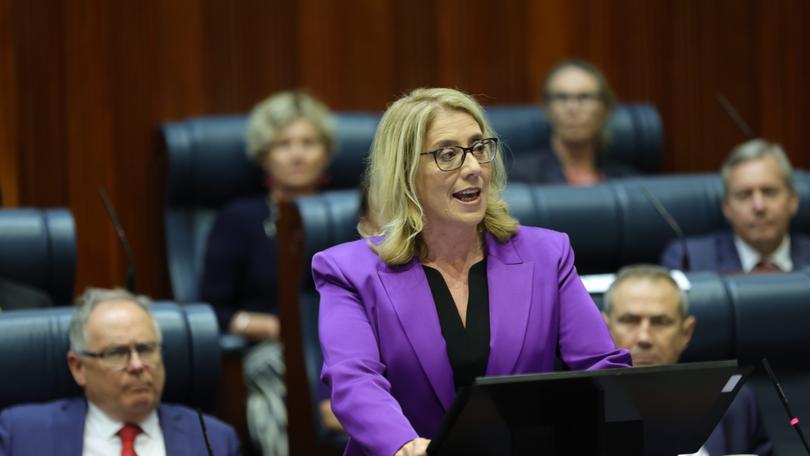WA State Budget 2024: West Australian economy the ‘envy of Australia’, says Treasurer Rita Saffioti

A resilient WA economy is the envy of the rest of Australia, the State Government says, with Treasurer Rita Saffioti to bank a $3.2 billion surplus next month and another near that level next year.
Fluctuations in commodity prices and delays in Commonwealth grant payments have pushed the surplus $100 million lower than expected at this time last year, but Ms Saffioti says this isn’t as good as it gets, with the growth “far from over”.
By next financial year, the surplus is tipped to be $2.6b — the Government’s seventh in a row – and surpluses are forecast to mid-2028. The lower surplus next year is attributed to the huge cost-of-living spending program, higher health and education spending and conservative forecasts for the economy and revenue.
Sign up to The Nightly's newsletters.
Get the first look at the digital newspaper, curated daily stories and breaking headlines delivered to your inbox.
By continuing you agree to our Terms and Privacy Policy.“No State provides more to the Federation than ours,” Ms Saffioti told Parliament in her Budget speech. WA has contributed one-fifth of economic growth over the past five years with 10 per cent of the national population.
Economic growth for the 2023-24 financial year, which ends June 30, is forecast to be 5.25 per cent
Business investment, on track to finish the current financial year up 13.25 per cent, is at a 10-year high — a reflection, Ms Saffioti says, of continued economic growth fuelling industry confidence. The growth of up to 4.25 per cent annually is expected through until 2027-28.
But the Treasurer insists the Budget — replete with a fourth round of $400 household electricity credits, previously announced payments to parents of school children and the State’s largest ever investment in infrastructure spending – isn’t inflationary.
“All the economic commentators say (the inflation challenge) is about housing and one of the constant threats that impacts the proposed decline of CPI is housing,” she said. “That’s why we’re pouring so much into increasing housing supply to try and reduce that impact on inflation.”
WA Treasury has forecast Perth’s inflation rate to be 3 per cent by mid-2025 and then 2.5 per cent by mid-2026, both excluding electricity given the Government’s credits, down from 3.4 per cent two months ago. The Reserve Bank of Australia’s target is between 2 and 3 per cent.
All levels of Government are under intense pressure to ensure Budgets are well-balanced and don’t further feed inflation after Reserve Bank governor Michele Bullock earlier this week warned interest rates may need to stay on hold for longer given overall inflation was proving particularly persistent. WA’s net debt is forecast to climb from $25.3b in 2024-25 to $29.2b in 2027-28, by then just under 10 per cent of Gross State Product.
Having posted the strongest population growth in the country for just over a year, WA’s annual population growth is expected to ease to 1.8 per cent by the middle of next year, down from 2.8 per cent the year prior, and then hold at 1.7 per cent growth for the following three years. This means WA will pass the three million people mark at some point next financial year.
In the year to September 2023, WA’s population increased by nearly 94,000.
“Our State’s prosperity and the huge amount of job opportunities have attracted a record number of people to the State, with more Western Australians in work than ever before, despite higher interest rates and mounting global uncertainties,” Ms Saffioti said.
She later told Parliament: “Just a few years ago, critics said people would never come to WA. The opposite has happened, with people flocking to our State.”
State baseline forecasts for the price of iron ore, its key economy driver, remain conservative but over the forward estimates from the 2026 to 2028 financial years have been bumped up from $US66 per tonne to $US71/t. They’re poised to finish 2023-24 at $US116.10/t and slide to $US75/t in 2024-25, compared to about $US100/t.
Total revenue from iron ore royalties is forecast to hit $9.85b in 2023-24 but fall 35.7 per cent to $6.3b in 2024-25 on assumptions the price will revert to its long-run average from November this year. Elsewhere, lithium royalties are thought to bottom out at $378m in 2024-25 before gradually recovering to $623m in 2027-28, while nickel is also thought to slide from $108m in 2023-24 to bottom out at just $88m in 2024-25.
Despite ongoing cost-of-living pressures, WA Treasury notes household spending in the State is holding up better than much of the country, supported by strong population growth, the labour market – with an unemployment rate below 4 per cent for the better part of two and a half years – and higher savings rates.
It expects household spending growth to hit 3 per cent by 2026-27, fuelled by population growth and ongoing income and employment growth and lower cost-of-living pressures.
The unemployment rate is poised to increase to 4.75 per cent by 2027-28 from 3.75 per cent from 2023-24.
Wages growth is expected to remain above its historical average over the near-term.
